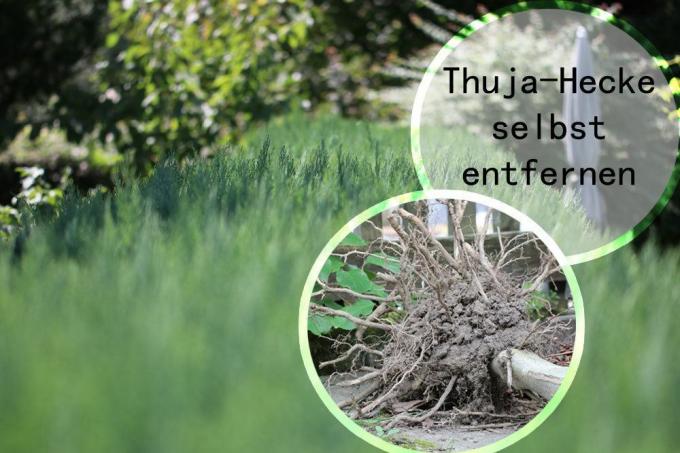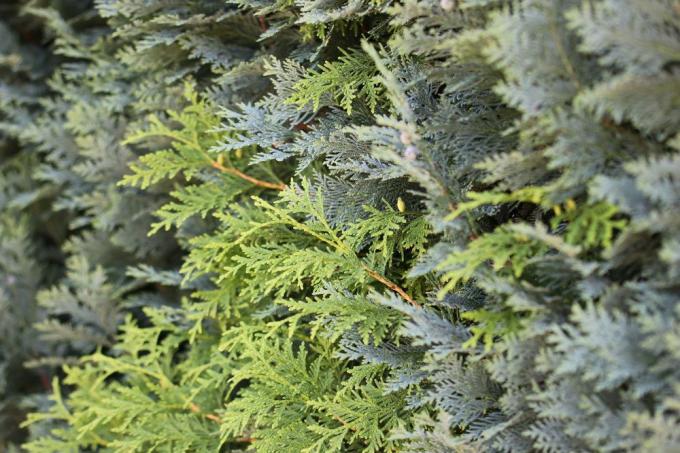
table of contents
- Remove thuja hedge
- time
- Observe neighborhood law
- Tools
- Remove the thuja hedge yourself
- Cut the hedge
- Remove roots
- Fill holes
- Let the rhizome rot
- Dispose of the hedge
In the 80s the thuja was a popular wood for privacy protection hedges. In the meantime, the tree of life has gone out of fashion, as the annual pruning is associated with a lot of effort and the wood often gets brown needles and shoots. The costs for removal by a specialist company should not be underestimated. With a few helpers by your side and the right tools, you can remove the thuja hedge yourself.
Remove thuja hedge
Have you seen enough of the thuja? If you want to remove your thuja hedge and take action yourself, you need to be aware of several things.
time
It is important that you follow the regulations of the Federal Nature Conservation Act note. During the breeding bird season, you must not remove the tree of life, like any other woody plant, as this could destroy nesting sites. The law provides that between 01. March and 31st September trees must be spared. Between 01. October and 28. February you can safely remove your thuja. Since the hedge is to be dug up completely, the weather plays only a minor role. To make your work easier, you should consider the following aspects:
- ideal soil conditions prevail after a rain shower
- Water loosens the soil
- work on frost-free days so that the soil is not too hard

Observe neighborhood law
If the hedge is on your property, it is considered your property. If a joint enclosure was agreed in the past, so that the hedge stands on your property and that of your neighbor, he or she has a say in removing the thuja. Also, find out whether you are benefiting from a Enclosure obligation are affected. The federal states regulate this obligation differently. While there are common fencing in some regions, other federal states regulate the question of the optical demarcation with the so-called legal fencing. This means that all immediate neighbors must visually delimit their right property line.
Note: If you are affected by the fencing requirement, you must replace the removed hedge in accordance with the local fencing types.
Tools
You will need equipment to cut off the top parts of the plant and other tools to remove the roots. Use hedge trimmers or pruning saws to cut up thinner trunks. Older hedges can develop very thick trunks that should be cut off with a chainsaw. For the Excavation A tarpaulin is recommended so that it can be removed more easily later. Other tools are useful for removing the roots:
- Spade and digging fork
- sharp hand saw
- small winch
Remove the thuja hedge yourself
Thuja plants develop a shallow root system that spreads just below the surface of the soil. The lateral expansion can be large in older hedges. The roots of several specimens intertwine with each other. As a result, it is hardly possible to remove individual plants.
Cut the hedge
Cut the hedge from the outside in and from top to bottom with a branch or hedge trimmer. The chainsaw is only used for logs with a larger diameter. The main trunk is sawn off just above the ground. Leave part of the trunk so that you can better remove the root system from the soil later.
Remove roots
Poke a large circle around the base of the trunk and dig out the earth until you hit the Root system meet. If the soil is too firm, loosen it up with water. Expose the entire rhizome. If there are roots in the way while digging, you can cut them through with a chainsaw. Use the digging fork to help loosen the rhizome. If this is not too big, you can use the digging fork to get it out of the ground.
tip: If you have a winch available, you can save yourself the hassle of digging. Attach the rope to the roots and trunk and let the winch do the work for you.
Fill holes
Fill the resulting holes in the ground with fresh plant substrate. Due to the needles of the thuja, the pH of the soil may have fallen into the acidic range. Certain plants like azaleas or rhododendrons get along well with the location. Many plants grow less well here because the conditions are no longer optimal. These plants have proven to be problem-free on such locations:
- Beach silver herb (Lobularia maritima)
- Patagonian verbena (Verbena bonariensis)
- Red spurflower (Centranthus ruber)
- Carnations (Armeria maritima or Armeria alpina)

tip: If you want to replant the site, get a pH meter. This will help you determine whether or not you need to recondition the soil.
Let the rhizome rot
If you have not planned any planting for the location, the thuja rhizome can remain in the ground and rot. To do this, drill holes in the roots and fill them with compost. The microorganisms accelerate the decomposition, which otherwise takes a long time. Cover the open space with fresh topsoil. If the ground subsides after a while, this indicates the ongoing rotting process. If necessary, top up with some soil and sow Grass seeds the end. Plants with deeper roots hardly find space for root formation.
Note: Did you know that the rhizome can sprout again? You should therefore saw the roots well or scratch them in several places so that soil organisms can penetrate.
Dispose of the hedge
Small cuts of low hedges can be chopped up and disposed of on the compost. Branches and trunks are good firewood. Let the material dry for at least a year, as the wood will be too wet in the first year and will lead to a lot of smoke. If larger quantities of clippings accumulate, it is advisable to dispose of them at a collection point. These usually calculate the costs incurred per cubic meter. In many regions, the local fire brigades collect wood cuttings free of charge in order to burn the remains at an Easter or solstice fire. You can also use the material profitably in the garden and in this way save costs for disposal:
- thicker logs make good material for a deadwood wall
- Needled branches offer winter protection for perennials
- Crushed material protects soil on slopes from erosion
- Rhizomes are decorative dead wood habitats for lizards and insects




